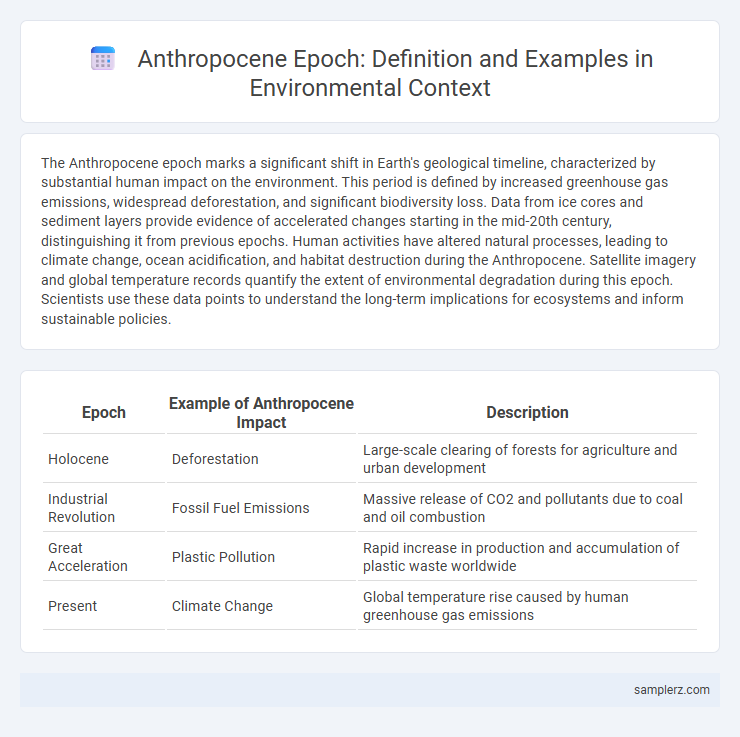The Anthropocene epoch marks a significant shift in Earth's geological timeline, characterized by substantial human impact on the environment. This period is defined by increased greenhouse gas emissions, widespread deforestation, and significant biodiversity loss. Data from ice cores and sediment layers provide evidence of accelerated changes starting in the mid-20th century, distinguishing it from previous epochs. Human activities have altered natural processes, leading to climate change, ocean acidification, and habitat destruction during the Anthropocene. Satellite imagery and global temperature records quantify the extent of environmental degradation during this epoch. Scientists use these data points to understand the long-term implications for ecosystems and inform sustainable policies.
Table of Comparison
| Epoch | Example of Anthropocene Impact | Description |
|---|---|---|
| Holocene | Deforestation | Large-scale clearing of forests for agriculture and urban development |
| Industrial Revolution | Fossil Fuel Emissions | Massive release of CO2 and pollutants due to coal and oil combustion |
| Great Acceleration | Plastic Pollution | Rapid increase in production and accumulation of plastic waste worldwide |
| Present | Climate Change | Global temperature rise caused by human greenhouse gas emissions |
Defining the Anthropocene Epoch
The Anthropocene Epoch is defined by significant human impact on Earth's geology and ecosystems, marked by extensive urbanization, widespread pollution, and climate change driven by fossil fuel emissions. Key indicators include altered sediment layers, plastic accumulation, and elevated greenhouse gases in the atmosphere. This epoch highlights the unprecedented scale of anthropogenic influence shaping the planet's future.
Industrial Revolution: Catalyst of the Anthropocene
The Industrial Revolution marked a pivotal catalyst of the Anthropocene epoch by accelerating carbon emissions and transforming global ecosystems through mass urbanization and fossil fuel dependency. Innovations like steam engines and mechanized factories intensified resource extraction and pollution, fundamentally altering the Earth's atmospheric and geological systems. These changes initiated long-term climate impacts, representing a significant shift in human influence on planetary processes.
Urbanization and Landscape Transformation
Urbanization in the Anthropocene epoch drives profound landscape transformation through extensive land conversion, habitat fragmentation, and increased impermeable surfaces. Rapid expansion of cities causes loss of biodiversity and alters natural hydrological cycles, leading to urban heat islands and disrupted ecosystems. These changes exemplify how human activities dominate geological processes, marking a distinct shift in Earth's environmental dynamics.
Plastic Pollution and Synthetic Materials
The Anthropocene epoch is notably marked by the proliferation of plastic pollution and synthetic materials, which have become ubiquitous in ecosystems worldwide. Microplastics have infiltrated marine environments, soil, and even the atmosphere, disrupting food chains and threatening biodiversity. These persistent synthetic compounds resist natural degradation, leading to long-term environmental accumulation and ecological imbalance.
Fossil Fuels and Atmospheric CO₂ Rise
The Anthropocene epoch is characterized by a significant increase in atmospheric CO2 levels primarily due to extensive fossil fuel combustion since the Industrial Revolution. This surge in greenhouse gases has accelerated global warming, contributing to climate change and ocean acidification. Scientific measurements show that CO2 concentrations have risen from approximately 280 ppm in pre-industrial times to over 420 ppm today, driven largely by coal, oil, and natural gas usage.
Biodiversity Loss and Mass Extinctions
The Anthropocene epoch is characterized by unprecedented biodiversity loss, with species extinction rates estimated to be 100 to 1,000 times higher than natural background rates, directly linked to human activities such as habitat destruction, pollution, and climate change. Iconic examples include the rapid decline of amphibian populations worldwide and the extensive deforestation in the Amazon rainforest, both contributing to mass extinction events. This accelerated loss of biodiversity threatens ecosystem stability and the services they provide, emphasizing the urgent need for conservation and sustainable environmental policies.
Global Agriculture and Land Use Change
Global agriculture drives significant land use change in the Anthropocene, with approximately 38% of Earth's terrestrial surface converted for cropland and pasture. This transformation results in habitat loss, soil degradation, and increased greenhouse gas emissions, contributing to climate change acceleration. Expansion of monoculture farming and deforestation for agriculture disrupts biodiversity and alters essential ecosystem services.
Ocean Acidification and Marine Impacts
Ocean acidification, driven by increased atmospheric CO2 from fossil fuel combustion, severely disrupts marine ecosystems by lowering seawater pH levels. This shift impairs calcifying organisms such as corals, mollusks, and plankton, compromising biodiversity and food webs critical to ocean health. In the Anthropocene epoch, these changes threaten fisheries, coastal protection, and carbon sequestration processes vital for climate regulation.
E-waste and Technosphere Growth
The Anthropocene epoch is characterized by unprecedented growth in the Technosphere, evidenced by the rapid accumulation of electronic waste (E-waste) globally. In 2023, over 57 million metric tons of E-waste were generated, containing hazardous materials and rare metals, significantly impacting ecosystems and human health. This surge in Technosphere development reflects the complex interplay between technological advancement and environmental sustainability challenges.
Nuclear Fallout in Geological Records
Nuclear fallout represents a defining marker of the Anthropocene epoch, visibly altering geological records through radioactive isotopes like Cesium-137 and Plutonium-239 found worldwide in soil and sediment layers. These artificial radionuclides provide a temporal signature starting from mid-20th century nuclear tests, distinguishing the Anthropocene from previous epochs. Their presence in stratigraphy highlights human impact on Earth's geology, serving as a unique anthropogenic boundary in the geological timeline.

example of anthropocene in epoch Infographic
 samplerz.com
samplerz.com